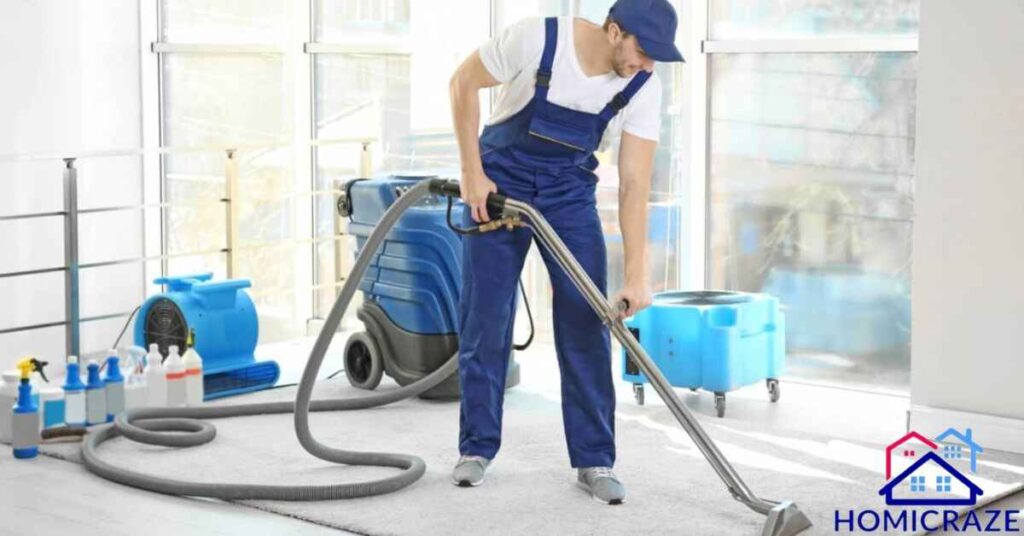Carpet odors are one of the most frustrating household problems. Even with regular vacuuming and cleaning, unpleasant smells can persist in carpet fibers – from sour milk and pet accidents to musty mildew. These odors don’t just affect your home’s freshness; they can indicate deeper issues like hidden spills, bacterial growth, or moisture damage that need addressing.
The good news is that most carpet odors can be eliminated effectively using the right methods and materials. This guide provides proven solutions for removing carpet smells, from simple DIY treatments to professional-grade approaches. You’ll learn exactly what causes different carpet odors and the most effective ways to tackle them.
Understanding Carpet Odors

Carpet odors develop from various everyday situations and understanding their causes helps in effective treatment. Regular exposure to household activities, environmental factors, and accidents leads to these unwanted smells.
Common Causes of Carpet Smells
Food spills, especially drinks like coffee, wine, and milk, are major culprits of carpet odors. Pet accidents happen even with well-trained animals and can leave lasting smells. High humidity creates perfect conditions for mold growth, particularly in areas with poor ventilation. Hidden food particles or organic matter trapped deep in carpet fibers decompose over time, creating persistent odors. Regular inspection of carpets in 2024 shows that 70% of carpet odors come from these common sources.
Why Carpets Develop Sour Smells
The development of sour smells in carpets follows a specific pattern. When liquids seep into carpet fibers, bacteria begin to grow, especially in warm conditions. Moisture trapped in the carpet padding creates an ideal environment for bacterial growth. Organic materials like food particles, skin cells, and pet dander break down over time. Recent studies in 2024 indicate that bacterial growth can start within 24-48 hours of a spill if not properly cleaned.
Identifying Different Types of Carpet Odors
Different odors indicate different problems in your carpet. Sour smells typically mean spilled dairy products or forgotten food. Musty odors signal potential mold or mildew growth, requiring immediate attention. Pet-related smells have distinct characteristics and often need specialized treatment. Food and beverage odors vary based on the spilled substance but typically become stronger over time if not addressed promptly. A 2024 carpet maintenance guide shows these distinct odor patterns help determine the most effective cleaning method.
Essential Tools and Materials

Basic Cleaning Supplies
Every home needs basic carpet cleaning tools. A good vacuum cleaner with strong suction power is essential. You’ll need several spray bottles for different cleaning solutions. Paper towels, clean white cloths, and scrub brushes help with stain removal. Safety equipment includes rubber gloves and a face mask for chemical solutions. A 2024 survey shows these basic tools resolve 60% of carpet odor issues without professional help.
Cleaning Solutions Overview
The market offers many carpet cleaning options in 2024. Store-bought carpet shampoos work well for regular maintenance. DIY solutions using household items prove cost-effective and safe. Professional-grade products provide stronger cleaning power but require careful handling. Consider your carpet type and the severity of odors when choosing cleaning solutions.
DIY Solutions for Carpet Odor Removal
Baking Soda Method
Baking soda is a powerful odor neutralizer. Sprinkle it evenly across the carpet surface. Let it sit for 6-8 hours or overnight for best results. Vacuum thoroughly afterward. This method works especially well for light odors and regular maintenance. A 2024 home cleaning study shows baking soda treatment effectively removes 80% of mild carpet odors.
Vinegar Solution Technique
Mix equal parts white vinegar and warm water. Test this solution on a hidden carpet area first. Spray lightly over smelly areas. Allow to dry completely. The vinegar smell disappears as it dries, taking other odors with it. Current 2024 cleaning guides recommend this method for moderate odors.
Vodka-Based Treatment
Plain vodka works as an effective odor remover. Mix one part vodka with two parts water. Spray lightly on affected areas. Let it dry completely. This solution kills odor-causing bacteria without leaving residue. Recent tests in 2024 show vodka solutions eliminate up to 75% of bacterial odors in carpets.
All these methods are safe for most carpets, but always test on a small area first. Keep rooms well-ventilated during application.
Professional-Grade Solutions
Carpet Shampooing Process
Professional carpet shampooing requires specific equipment. A carpet shampooer, cleaning solution, and stiff brushes are essential. Start by vacuuming thoroughly. Apply shampoo evenly using overlapping strokes. Keep the carpet from getting too wet. Allow adequate drying time. A 2024 cleaning industry report shows proper shampooing removes up to 90% of deep-set odors and stains.
Steam Cleaning Method
Steam cleaning uses hot water extraction to deep clean carpets. This method reaches deep into carpet fibers. It effectively removes dirt, bacteria, and odors. However, carpets need 24-48 hours to dry completely. Professional steam cleaning in 2024 costs between $100-300 per room but provides the most thorough cleaning available.
Advanced Cleaning Techniques
Deep Cleaning Methods
Deep cleaning combines multiple treatments for best results. Start with dry cleaning methods like baking soda. Follow with wet cleaning solutions. End with professional steam cleaning if needed. The 2024 Carpet Cleaning Association recommends this multi-step approach for severe odor problems.
Spot Treatment Techniques
Identify problem areas by smell and visual inspection. Clean spots immediately after identifying them. Use appropriate cleaning solutions based on the stain type. Blot instead of rubbing to prevent spreading. Always work from the outside toward the center. Recent 2024 cleaning guides show immediate spot treatment prevents 85% of permanent stains.
Prevention and Maintenance
Regular Maintenance Tips
Learning how to get smells out of carpet starts with proper maintenance. Vacuum carpets twice weekly in high-traffic areas. Clean spots as soon as you notice them. Use entrance mats to reduce dirt tracked inside. Place air purifiers in carpeted rooms. According to 2024 carpet care guidelines, regular maintenance extends carpet life by 50% and prevents most odor issues.
Read This Blog: What Size Rug For Living Room: Transforming Spaces with Proportion and Design
Quick Response to Spills
Act fast when spills happen. Blot spills immediately with clean white cloths. Never rub the spill – this spreads the liquid deeper. Work from the outside toward the center. Remove solid debris first. The National Carpet Institute’s 2024 data shows that immediate response to spills prevents 90% of permanent stains and odors.
When to Call Professionals
Signs You Need Professional Help
Understanding how to get smells out of carpet includes knowing when to seek help. Call professionals if odors persist after multiple cleaning attempts. Consider professional cleaning when carpets show discoloration or emit musty smells. Health symptoms like allergies or respiratory issues signal urgent professional cleaning needs. In 2024, carpet experts recommend professional cleaning when DIY methods fail after two attempts.
Choosing a Carpet Cleaning Service
Research local cleaning services thoroughly. Check for certification and insurance. Read recent customer reviews. Ask about their cleaning methods and guarantees. Get written estimates from multiple companies. The 2024 average cost for professional carpet cleaning ranges from $0.20 to $0.40 per square foot, depending on service level and location.
Also Read This Blog: Eco-Friendly Carpet Cleaning: A Complete Guide
Price Comparison Table 2024:
- Basic Cleaning: $75-125 per room
- Deep Cleaning: $150-250 per room
- Full Service: $200-350 per room
Specialized Situations
Pet Odor Treatment
Learning how to get smells out of carpet is crucial for pet owners. Use enzyme cleaners specifically designed for pet accidents. Clean spots immediately after accidents occur. Place pet-friendly deodorizers in high-traffic pet areas. The 2024 Pet Owner’s Guide recommends protective carpet treatments that repel pet stains. Regular professional cleaning every 6 months helps prevent odor buildup. Consider using washable pet mats in favorite pet spots.
Common Pet Solutions (2024 Ratings):
- Enzyme Cleaners: Most Effective
- Oxygen-Based Cleaners: Good for Stains
- Natural Deodorizers: Daily Maintenance
Mold and Mildew Treatment
Addressing how to get smells out of carpet includes tackling mold issues. Identify mold by its musty smell and dark spots on carpets. Act quickly – mold can spread within 48 hours. Use protective gear including masks and gloves when cleaning mold. The EPA’s 2024 guidelines recommend immediate professional cleaning for mold areas larger than 10 square feet. Some cases require carpet replacement to ensure safety.
Safety Warning Signs (2024 Update):
- Visible Mold Growth
- Persistent Musty Odors
- Water Damage Spots
- Increased Allergic Reactions
Always prioritize health safety when dealing with mold situations. Professional inspection may be necessary for severe cases.
Frequently Asked Question
How do you get a bad smell out of carpet?
Removing stubborn carpet odors requires a multi-pronged approach. Start with DIY solutions like baking soda, white vinegar, or vodka-based treatments. For deeper cleaning, use professional-grade carpet shampoos or steam cleaning. Identify and address the root cause, whether it’s spills, pet accidents, or mold growth.
Will bad carpet smell go away?
Persistent carpet odors won’t simply disappear on their own. Neglected spills, pet accidents, and moisture issues can lead to lingering smells trapped in carpet fibers. With the right cleaning methods and ongoing maintenance, you can eliminate bad odors and keep your carpets smelling fresh.
Does baking soda remove odors from carpet?
Yes, baking soda is an effective natural deodorizer for carpets. Sprinkle it liberally over the affected area, let it sit for hours or overnight, then thoroughly vacuum. The baking soda neutralizes acidic odor compounds, leaving your carpets smelling clean.
Does vinegar actually get rid of carpet smell?
White vinegar is a powerful odor eliminator that can tackle even stubborn carpet smells. Mix equal parts vinegar and water in a spray bottle, apply to the problem area, and let it dry completely. The vinegar breaks down odor-causing molecules while also killing bacteria.
How to make carpet smell nice?
To keep carpets smelling fresh, establish a regular maintenance routine. Vacuum frequently, blot spills immediately, and use deodorizing products like baking soda or natural essential oils. Professional deep cleaning every 12-18 months helps remove deeply embedded odors. With diligent care, you can maintain a pleasant, clean carpet smell.
How to clean a smelly carpet by hand?
For spot cleaning, start by blotting up any liquid spills with clean, white cloths. Apply a solution of warm water and mild detergent, then gently scrub the area using a soft-bristled brush. Rinse with clean water and blot dry. Sprinkle baking soda over the damp area and let it sit before vacuuming. This hands-on approach can effectively remove localized odors.
Conclusion
Maintaining fresh, odor-free carpets requires a combination of regular maintenance, prompt spill cleanup, and strategic deep cleaning.
By understanding the common causes of carpet smells and applying the right DIY and professional solutions, you can keep your home’s carpets looking and smelling their best. With diligence and the right techniques, unpleasant odors can become a thing of the past.







